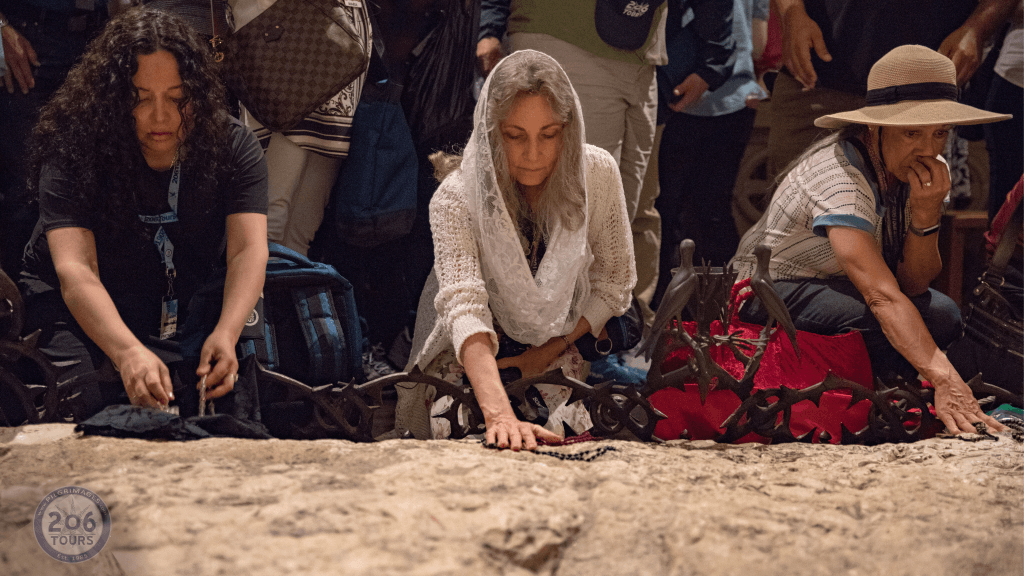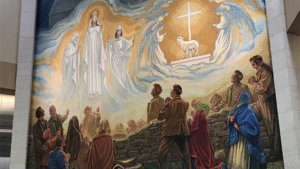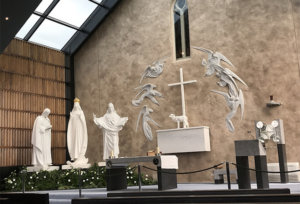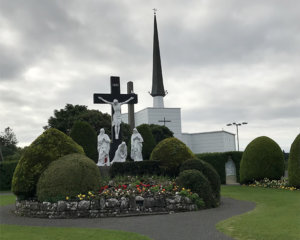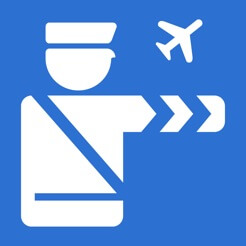Month: August 2018
Many Pilgrimages visit important Shrines that house Sacred Catholic Relics. Understanding the way relics are classified in the Catholic Church is important to fully appreciate these amazing pieces of our shared history and why they are so strongly venerated.
A Relic, in religious terms, usually refers to the physical remains or personal effects of a Saint or Holy person that have been saved and preserved in an official reliquary, also known as a Shrine. The Catholic Church recognizes three classes of relics.
1. First-Class Relics
The most sacred class, a first-class relic refers to an item that is directly associated with the life of Jesus Christ. However, the physical remains of a Saint’s body are also classified as first-class relics. In many cases, this type of first-class relic is entombed in an altar stone.
An example of a famous first-class relic can be found in Bethlehem in the Church of the Nativity in Manger Square. It is in the Grotto of the Nativity that you can see a relic of the original Manger at the place of Jesus’ birth – now marked by a star in the floor.
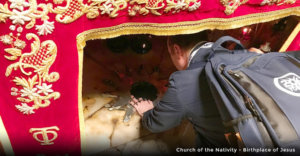
Join us in the Holy Land – Walk Where Jesus Walked Tour.
Another example of a first-class relic is the incorrupt body of St. John Vianney, the patron Saint of Parish Priests, whose remains are entombed above the main altar in the Basilica in Ars-sur-Formans in France.
You can visit Ars on our Great Shrines of France Tour.
2. Second-Class Relics
A second-class relic is typically a personal belonging of a Saint or Holy person. In many cases, this is a piece of clothing or an object used by the Saint. The Latin term, “Ex indumentis”, meaning “from the clothing”, is often used when referring to a second-class Holy relic.
A famous example of a second-class relic is the chain that attached the Apostle Paul to the Roman soldier while imprisoned in Rome, which is housed in the Papal Basilica of St. Paul Outside the Walls.
You can visit this Basilica on our Shrines of Italy Tour.
3. Third-Class Relics
An object that has been touched to a first-class relic is classified as a third-class relic. Many Catholics will bring a Crucifix or Rosary to a shrine and touch it to the venerated relic, thereby making it a third-class relic. However, unlike first and second-class relics, third-class relics will not be formally recognized with official documentation.
Traveler’s Tip: Third-Class Relics Make Great Gifts!
When traveling in the Holy Land, you can visit all of the sites, and in the order of the Gospel. You will have the opportunity to enter the Tomb in the Church of the Holy Sepulchre, touch the Rock of Agony in the Church of All Nations, touch the star in the Grotto of the Church of the Nativity .. and many more. Bring extra Rosaries with you – and have them in hand when you touch each spot. This way, you can gift friends and family members with Third Class Relics when you return home!
Father Seán Connolly pictured above at the Knock Shrine while on a Pilgrimage with 206 Tours.
For the past several years, Father Seán Connolly has been a Spiritual Director on a number of 206 Tours Pilgrimages, guiding pilgrims to experience their faith in new ways in Catholic sites like the Holy Land, Fatima, Spain, Lourdes, Mexico, and Ireland.
Fr. Connolly is the currently the Parochial Vicar at Immaculate Conception and Assumption of Our Lady Parish in Tuckahoe, New York. He recently authored an essay which was just featured on Catholic World Report’s, “The Dispatch”, about the 1879 apparitions in Knock, Ireland.
As the World Meeting of Families begins this week in Ireland, we’re excited to share his inspiring message and insights with you below.
The Unspoken Message of Heaven at Knock
Published August 21, 2018 originally featured on Catholic World Report “The Dispatch”, seen here.
Written by Father Seán Connolly
139 year ago this very day, an unspoken message from heaven came to our world at the rural wayside village of Knock, Ireland. The little hamlet was a forgotten corner of the earth in 1879. It consisted of a dozen houses or so, along with the little parish church, the rectory, a school-house, a post office and a few small shops. The village and the social condition of its people at the time, was in many respects like that of the little village of Nazareth in the days of our Lord Jesus. It was poor, peaceful and unknown. Both were under the oppression of a foreign occupier—for Nazareth two thousand years ago it was the Romans, and for Knock a century and a half ago it was the English. The Penal Laws were imposed upon the Irish in attempt to stamp out their Catholic faith; those laws were as degrading as they were oppressive.
Painting at the Knock Shrine captured by Fr. Connolly
Just as they began to be relaxed though not repealed, more misery struck the people of western Ireland. The Great Famine which was proximately caused by potato blight but worsened on account of the repression imposed by the occupying government, resulted in the deaths of one million while another million were to emigrate, reducing the island’s population dramatically. The Great Famine took place between 1845 and 1849, but its last waves continued up until the time of the astonishing event that took place in Knock. Further potato blight was always the great fear. And in that year of 1879, that fear was realized when the crop was found to be a complete failure. The only prospect in the time ahead was further hunger and misery. It was in the midst of this struggle and sorrow that the miraculous message appeared before the villagers of Knock in front of the gable wall of their parish church.
The whole day of August 21, 1879 was marked by a dismal downpour of rain from dawn until dusk. The dreariness was an apt metaphor for a nation plagued by poverty, hunger and oppression. At about 7:30 in the evening, a young woman of the village named Mary Byrne was accompanying Mary McLoughlin, the priest’s housekeeper, to her home. As they came in sight of the gable wall of the little parish church, Mary Byrne remarked to the priest’s housekeeper, “O, look at the statues. Why didn’t you tell me the priest had got new statues for the chapel?” But Mary McLoughlin said she’d heard nothing about them. On coming nearer, however, Mary Byrne said: “But they’re not statues, they’re moving. It’s the Blessed Virgin!” She ran home to tell her widowed mother as well as her brothers and sister and soon others had gathered.
There were fifteen primary witnesses who gave documented testimony of what they saw, but as many as 25 to 30 were reported to have seen the vision. They ranged in age from five to 74. Together in the pouring rain they beheld the beautiful spectacle. The Blessed Virgin Mary was in the center of the apparition. She was wearing a large brilliant gold crown and was clothed in white garments. Her hands were raised in prayer and her eyes gazed toward heaven. To her right was her spouse, St. Joseph, whose head was inclined toward her. To her left was St. John the Evangelist, who was attired as a bishop wearing a miter and was holding a book, perhaps the Gospel he wrote, in his left hand. His right hand was raised as if he was preaching. To the left of St. John was an altar on which stood a cross and a lamb surrounded by angels.
The eldest of the visionaries, the 74-year-old Bridget Trench, in an act of natural and humble piety, approached the vision to kiss the Virgin’s feet. She was, however, unable to do so. She could not touch what she saw with her eyes and only passed through the image to feel the gable wall of the church in her attempt. The vision lasted for a full two hours. Though it was raining, the ground beneath the vision was dry. A light emanating from the heavenly figures was witnessed by a farmer about half a mile away from the scene.
The enigma of the apparition at Knock was its silence. We can only speculate as to why this is. Surely the reason goes deeper than the fact that at least two of the visionaries did not speak the same language. The oldest among them, Bridget Trench, knew only Irish while the youngest, John Curry, knew only English. No message was imparted to the visionaries as there was by our Lady at Lourdes or Fatima. In those two famous apparitions the Mother of God requested more acts of penance, but such was not the case at Knock. The Irish people had suffered and done penance enough; no suffering or pain should ever be wasted. Those devout Catholic souls knew well that they must in prayer and place themselves in union with Christ’s own suffering. And this offering was answered by the celestial vision at Knock, whose unspoken message was one of love and solidarity with the perseveringly faithful Irish in their time of suffering and sorrow.
Picture of the Altar at the Knock Shrine taken by Father Connolly
Reports of “strange occurrences in a small Irish village” were featured almost immediately in the press, notably by The Times of London. Many miracles were reported, which were methodically recorded in the diary of the parish priest. For example, ten days after the apparition a mother brought her little girl to the gable wall of the church. The young Delia Gordon, had always been deaf in her left ear; her mother placed a small amount of cement or grout from the gable wall into her ear and said a prayer for healing. A little later during Mass, Delia felt an excruciating pain in her ear follow by immediate relief. Her ear had been healed and hearing restored. The apparition wall soon being torn apart by pilgrims chipping out the cement, mortar, and stones to have as relics and to use for prayer.
Two inquiries were held to study the reported apparition and to determine its authenticity. Unlike at Lourdes, no medical commission was ever established at Knock to verify whether claimed cures are unexplainable according to the medical sciences. The first commission of inquiry was established by the Archbishop of Tuam in October of 1879. Fifteen of the witnesses were formerly deposed and the commission’s members deemed their accounts to be trustworthy. In 1936, a second commission of inquiry was established to study the matter further, which relied upon interviews with the last of the surviving witnesses who all confirmed their prior testimony. Even John Curry, who was only four when he saw the vision and had since emigrated to America, was called (under threat of ecclesiastical penalty if he failed to show) to the chancery of the Archdiocese of New York to testify.
In this same commission, the aged Mary Byrne poignantly stated: “I am clear about everything I have said and I make this statement knowing I am going before my God.” She died only six weeks later. This second commission, like the first, deemed the testimonies given to be trustworthy.
It is now a commonly accepted pious belief that heaven favored the parish of Knock in particular because of the holiness of its parish priest Archdeacon Bartholomew Cavanagh. He was known for his deep devotion to the Blessed Virgin, the Holy Souls in Purgatory, his penances (he wore a hair shirt), and for living very simply. He was told about the vision before the gable wall of his church but chose not to join his parishioners outside. This has been attributed either to a miscommunication or his disbelief. He later said that not witnessing the apparition “has been to me a cause of the deepest mortification. But I console myself with the reflection that it was the will of God that the Apparition should be shown to the people, not the priest.” Yet it is believed in Knock today that the Archdeacon was frequently favored with visits of our Lady in his own little cottage, and so knew well what was occurring but chose to leave the heavenly vision to be for the sole benefit of his flock. Indeed, many other miraculous manifestations surrounding him were reported but he always requested those who observed them to speak of them to no one.
Statues outside the Knock Shrine, photo credit Father Connolly.
Today there is a large shrine built in honor of the apparition at Knock in County Mayo, Ireland. Over one and a half million people make a pilgrimage there each year. I was fortunate to be one of them this past month, a visit which inspired me to write this essay so more may come to know the unspoken message of heaven given at this holy place.
In just a few days, the Pope himself will go to Knock as a pilgrim while on his apostolic visit to Ireland. It will be a daunting trip. The Church in Ireland is devastated. Christopher Altieri described the current situation well in a recent essay for The Catholic Herald:
“The once proudly, fiercely Catholic people of Ireland are reeling and bitterly angry over the years of systematic abuse committed by priests and religious, and the coverup of that abuse by Church leaders. They’ve stopped going to Mass. They voted to amend their constitution to allow same-sex marriage in 2015 – even while marriage itself declines… Just this year, the Irish people voted to remove a constitutional protection on children in the womb. It would be hard – but fair – to say that the Irish people are in rebellion against the Faith – though it is not hard to understand the roots of that rebellion.”
There are no words the Holy Father can utter to make up for the failures of the Church or to quickly reverse the tide of secularization. But like the heavenly vision given in Knock, his presence among the hurting Irish Church can be one of union and solidarity in a time of trial. This unspoken message will, I think, be the most important one. And through the intercession of Our Lady of Knock the Queen of Ireland, may it at least begin the process of healing and the Irish people’s return to their greatest legacy—the Catholic faith.
Thank you to Father Seán Connolly for this detailed and insightful account of the Marian Apparition at Knock. To read the article on Catholic World Report’s website, click here.
To visit Ireland and the Knock Shrine on a Pilgrimage, check out Tour 202 here.
[DISPLAY_ULTIMATE_SOCIAL_ICONS]Many people look forward to traveling for months but dread the airport experience of long lines, confusing information, and large airports that may be hard to navigate. Here are five (5) Apps that are FREE, available in the App Store on your Phone, and can help make your airport experience as quick and seamless as possible.
1. MyTSA App
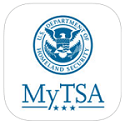
To download, click here.
2. Mobile Passport App – Customs and Immigration
The Mobile Passport App is available for use at 25 US Airports so far (a full list can be found here on link below). This App has been endorsed by the Department of Transportation and can help to prevent long wait times that can accompany the customs line upon return as it allows you to fill out the customs form online – rather than on the traditional paper form. Simply download the app, set up your profile using the information listed on your passport, and use the app each time you are at your port of entry and receive your receipt.
To download, click here.
3. GateGuru
This App will give you real-time updates on your departure time, Terminal, and Gate – as well as any changes to your itinerary like Security wait times, Delays, Gate changes, or Layover time adjustments. It will also show you all the amenities, restaurants, and shops in the area so that you don’t have to waste time walking out of your way to find a restaurant, cup of coffee, or neck pillow.
To download, click here.
4. Google Maps
Google Maps has started to map out the interiors of many large airports which can be helpful if you’ve lost your bearings when looking for your gate or when changing terminals.
To download, click here.
5. Google Translate
Google Translate is always a good idea to have downloaded when traveling to foreign countries. In many international airports you will find English directions and signs easily, however, if you do find yourself in a jam, simply type a bit of foreign text into the app or even take a picture of a sign, and the app will provide you with a translation.
To download, click here.
For more helpful information regarding airports and international travel, reference our free online Final Instruction Booklets entitled, “Know Before You Go”
[DISPLAY_ULTIMATE_SOCIAL_ICONS]
